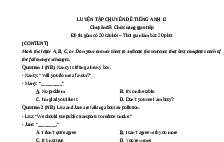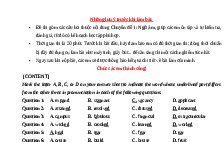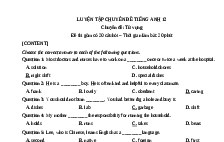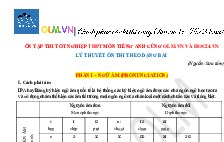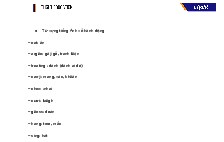[2K3 THỨC KHUYA HỌC BÀI] ÔN TẬP THI HỌC KÌ 2- BUỔI 8- ĐỌC HIỂU.
Nội dung tài liệu
Tải xuống
Link tài liệu:
Các tài liệu liên quan
-
![Đề luyện tập Chuyên đề 3: Chức năng giao tiếp]()
-
![Đề luyện tập Chuyên đề 1: Ngữ âm]()
-
![Đề luyện tập Chuyên đề 2: Từ vựng]()
-
![Tài liệu ôn tập HKII năm học 2020-2021 môn Tiếng Anh 12 chương trình cũ, trường THPT Xuân Đỉnh - Hà Nội]()
-
![Lý thuyết ôn thi THPT môn Tiếng Anh theo dạng bài]()
-
![UNDERSTAND]()
-
![TỪ VỰNG VỀ CÁC MÔN HỌC]()
-
![Tuyển tập truyện ngắn song ngữ Anh-Việt hay]()
-
![Tuyển tập truyện cổ tích bằng tiếng Anh]()
-
![TỪ VỰNG VỀ HÀNH ĐỘNG]()
Có thể bạn quan tâm
Thông tin tài liệu
CÔ PHẠM LIỄU
[DẬY SỚM HỌC BÀI CÙNG HỌC SINH 2K3]
ÔN TẬP HỌC KÌ 2- BUỔI 8
ĐỌC ĐIỀN- ĐỌC HIỂU
Read the following passage and mark the letter A, B, C, or D on your answer sheet to indicate the correct answer to each
of the questions.
Thrill seekers in Japan will soon get to enjoy their favorite roller coasters again now that amusement parks around the
country are reopening after the coronavirus-related lockdown. But there's one request they might struggle with: No
screaming.
With Japan lifting the state of emergency this week, a group of major theme park operators has introduced a set of
guidelines on how to ensure the safety of both guests and staff in the face of COVID-19. Many of the items are to be
expected, recommending increased sanitizing measures, regular body temperature checks and face mask use while
emphasizing the importance of practicing social distancing.
However, some items will likely take visitors by surprise, namely a suggestion that theme parks encourage visitors
riding outdoor attractions, including roller coasters, to avoid shouting or cheering, which is obviously no mean feat. The
guidelines also say that if it's difficult for some employees to wear masks due to the nature of their work for example
entertainers, such as haunted house staff, they should keep at least one meter away from visitors.
Customer service may also be compromised, note the guidelines, as conversations should be kept as short as
possible. "As a new style of customer service, even when you're wearing a mask, you can use a combination of smiley eyes,
hand gestures, etc., to effectively and safely communicate with visitors," says one of the suggestions.
(Adapted from edition.cnn.com)
Question 1: What is the best title for this passage?
A. Japan Amusement Parks Issuing New And Unusual COVID-19 Guidelines
B. How Will Social Distancing Be Maintained When Amusement Parks Open?
C. How Customer Service At Amusement Parks Will Change After COVID-19
D. Japan Is Telling People Not To Scream On Roller Coasters. Is This Possible?
Question 2: How can those who work in customer service communicate with visitors effectively and safely while wearing
masks?
A. They can sometimes take off their mask if needed
B. They can refuse to continue the conversation
C. They can use non-verbal signals instead of talking
D. They can use facial expressions and gestures
Question 3: Which of the following is NOT mentioned as an item in the newly issued guidelines for Japan’s amusement
parks?
A. increased sanitizing measures
B. mask use for all employees
C. frequent temperature checks
D. practice of social distancing
Question 5: The word “they” in paragraph 3 refers to ___________.
A. guidelines
B. employees
C. masks
D. visitors
Question 4: The word “compromised” in paragraph 4 is closest in meaning to __________.
A. weakened
B. undermined
C. damaged
D. discredited
Read the following passage and mark the letter A, B, C, or D on your answer sheet to indicate the correct answer to each
of the questions.
Studies are now revealing that the number of individuals who carry and can transmit the new coronavirus, yet remain
completely asymptomatic, is larger than originally thought.
The realisation that asymptomatic people can spread an infection is not completely surprising. In fact, all bacterial,
viral and parasitic infections – ranging from malaria to HIV – have a certain proportion of asymptomatic carriers. Research
has even shown that at any one time, all of us are infected with between eight and 12 viruses, without showing any
symptoms.
Despite this knowledge, many public health officials in countries around the world failed to take into account the
threats posed by asymptomatic transmission of COVID-19. This is largely because they were working on models based on
Cô Phạm Liễu - https://www.facebook.com/lieupham.fatima
Page 1
CÔ PHẠM LIỄU
[DẬY SỚM HỌC BÀI CÙNG HỌC SINH 2K3]
influenza, which suggest that only 5% of people infected are asymptomatic. As a result, the large scale diagnostic testing
regimes required to pick up asymptomatic COVID-19 cases were not in place until too late. “I warned on 24 January to
consider asymptomatic cases as a transmission vehicle for COVID-19, but this was ignored at the time,” says Bill Keevil,
professor of environmental healthcare at the University of Southampton.
While scientists still can’t conclude whether asymptomatic people are as contagious as those who display symptoms,
there are still many ways in which they can pass on COVID-19, says Rein Houben, an infectious diseases researcher at the
London School of Hygiene and Tropical medicine. Houben points out that, because most asymptomatic people have no idea
they are infected, they are unlikely to be self-isolating, and studies have shown this has contributed to the rampant spread of
the virus in facilities such as homeless shelters and care homes. He says this means there is a need for regular diagnostic
testing of almost all people in such closed environments, including prisons and psychiatric facilities.
“When it comes to controlling Covid-19, this really shows that we cannot rely on self-isolation of symptomatic cases
only,” says Houben. “Going forwards we need trace and test approaches to account for individuals who are not reporting any
symptoms.”
(Adapted from theguardian.com)
Question 6: Which best serves as the title for the passage?
A. The Global Health Officials’ Mistake That Made COVID-19 Spread Faster
B. Uncontrolled COVID-19 Spread In Confined Spaces: What Are The Causes?
C. Asymptomatic COVID-19 Cases: A Bigger Threat Than Initally Thought
D. Why Do Some People Carry The Coronavirus Without Showing Symptoms?
Question 7: According to paragraph 2, the fact that an infection can be spread by people who display no symptoms is
__________.
A. a groundbreaking finding that would help us stop the coronavirus
B. very important but still mostly ignored by global health officials
C. an evidence that health officials do not understand COVID-19
D. not very astonishing given what we have learned about viruses
Question 8: The word “they” in paragraph 2 refers to __________.
A. officials
B. countries
C. threats
D. models
Question 9: The word “vehicle” in paragraph 3 can be best replaced by ___________.
A. technique
B. method
C. machine
D. process
Question 10: According to paragraph 3, what is the main reason why health officials neglected the risks of asymptomatic
COVID-19 transmission?
A. Because they lacked diagnostic testing equipment to detect asymtomatic cases.
B. Because the models they use underestimated the proportion of asymptomatic cases.
C. Because they wrongly applied what they know about other diseases like influenza.
D. Because testing regimes to gather data about asymptomatic cases were not in effect.
Question 11: The word “rampant” in paragraph 4 is closest in meaning to ___________.
A. dynamic
B. assertive
C. forceful
D. unchecked
Question 12: Which of the following is NOT TRUE, according to the passage?
A. Those infected with malaria or HIV can still display no symptom of these diseases.
B. Large scale testing regimes to find asymotmatic cases were not put in place in time.
C. Asymptomatic COVID-19 cases are much more infectious than symptomatic ones.
D. People showing no symptoms after infection can still spread diseases in many ways.
Question 13: Which of the following can be inferred from the passage?
A. COVID-19 is the disease with the highest percentage of asymptomatic cases.
B. Professors at universities know more about COVID-19 than health officials do.
C. Unless asymptomatic cases are taken into account, COVID-19 cannot be stopped.
D. Asymtomatic cases are the largest contributing factor to the spread of COVID-19.
Cô Phạm Liễu - https://www.facebook.com/lieupham.fatima
Page 2


